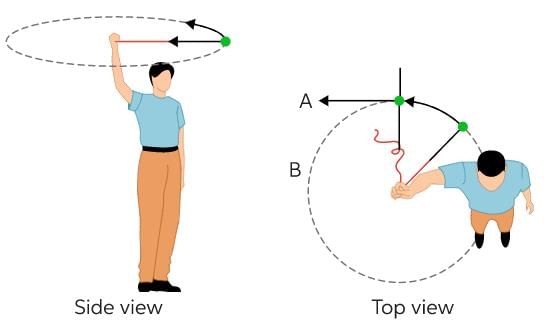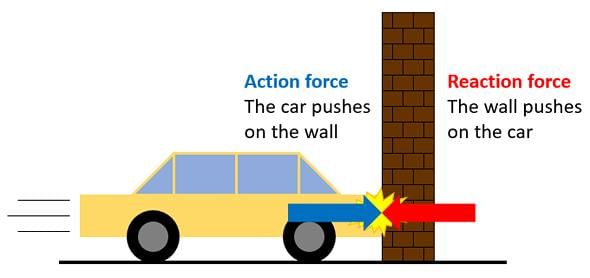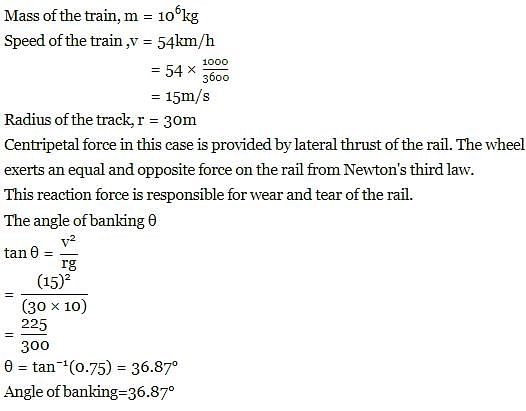Test: Laws of Motion II - NEET MCQ
30 Questions MCQ Test Physics Class 11 - Test: Laws of Motion II
A stone of mass 0.25 kg tied to the end of a string is whirled round in a circle of radius 1.5 m with a speed of 40 rev./min in a horizontal plane. The speed is then increased beyond the maximum permissible value, and the string breaks suddenly, which of the following correctly describes the trajectory of the stone after the string breaks.
A man of mass 70 kg stands on a weighing scale in a lift which is moving upwards with a uniform speed of 10 m s−1, what would be the reading on the scale?
Give the magnitude and direction of the net force acting on a stone of mass 0.1 kg lying on the floor of a train which is moving with 1 ms−2 accleration , the stone being at rest relative to the train. Neglect air resistance.
According to Newton's third law of motion, the action and reaction forces are
Give the magnitude and direction of the net force acting on a stone of mass 0.1 kg lying on the floor of a train which is accelerating with 1 ms−2, the stone being at rest relative to the train. Neglect air resistance.
A man of mass 70 kg stands on a weighing scale in a lift which is moving upwards with a uniform acceleration of 10 ms−2 what would be the reading on the scale?
A helicopter of mass 1000 kg rises with a vertical acceleration of 15 ms−2. The crew and the passengers weigh 300 kg. Give the magnitude and direction of the force on the floor by the crew and passengers,
A train runs along an unbanked circular track of radius 30 m at a speed of 54 km/h. The mass of the train is 106 kg. What is the angle of banking required to prevent wearing out of the rail ?
A constant retarding force of 50 N is applied to a body of mass 20 kg moving initially with a speed of 15 m s−1How long does the body take to stop?
A man of mass 70 kg stands on a weighing scale in a lift which is moving upwards with a uniform acceleration of 5 ms−2 what would be the reading on the scale?
A monkey of mass 40 kg climbs on a rope which can stand a maximum tension of 600 N. In which of the following cases will the rope break. When the monkey
(a) Climbs up with an acceleration of 6 ms−2.
A rocket with a lift-off mass 20,000 kg is blasted upwards with an initial acceleration of 5.0 ms-2. Calculate the initial thrust (force) of the blast.
Two bodies of masses 10 kg and 20 kg respectively kept on a smooth, horizontal surface are tied to the ends of a light string. a horizontal force F = 600 N is applied to the 20 kg mass so as to pull it. What is the tension in the string?
A monkey of mass 40 kg climbs on a rope which can stand a maximum tension of 600 N. What is the tension in the rope if the monkey climbs down with an acceleration of 4 ms−2
A truck starts from rest and accelerates uniformly at 2.0 ms−2. At t = 10 s, a stone is dropped by a person standing on the top of the truck (6 m high from the ground). What is the magnitude of acceleration (in ms−2 ) of the stone at t = 11s? (Neglect air resistance.)
A monkey of mass 40 kg climbs on a rope which can stand a maximum tension of 600 N. What is the tension in the rope if the monkey climbs up with a uniform speed of 5 ms−1
A stationary ball weighing 0.25kg acquires a speed of 10m/s when hit by a hockey stick. The impulse imparted to the ball is
A bob of mass 0.1 kg hung from the ceiling of a room by a string 2 m long is set into oscillation. The speed of the bob at its mean position is 1 ms−1. What is the trajectory of the bob if the string is cut when the bob is at one of its extreme positions
|
97 videos|379 docs|103 tests
|



























